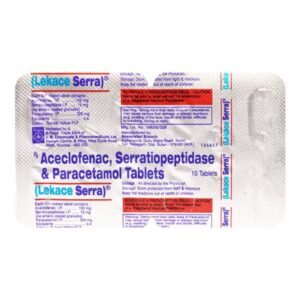PARACETAMOL + ACECLOFENAC + SERRATIOPEPTIDASE
Paracetamol: Paracetamol, also known as acetaminophen, is a common over-the-counter medication that is widely used for its pain-relieving and fever-reducing properties. It belongs to the class of drugs called analgesics and antipyretics.
Paracetamol is primarily used to relieve mild to moderate pain such as headaches, toothaches, menstrual cramps, and muscle aches. It is also effective in reducing fever in individuals with conditions such as the common cold or flu. Paracetamol can be found in tablet, capsule, liquid, and suppository formulations, making it easily accessible for different age groups and preferences.
The exact mechanism of action of paracetamol is not fully understood. However, it is believed to work by inhibiting the production of prostaglandins, which are chemical messengers that play a role in the transmission of pain signals and the regulation of body temperature. By reducing the production of these chemical messengers, paracetamol helps to alleviate pain and bring down fever.
The standard recommended dose of paracetamol for adults is usually 500 to 1000 milligrams (mg) every four to six hours, with a maximum daily dose of 4000 mg. It is important to carefully read and follow the instructions on the packaging for the specific product being used, as dosing may vary depending on the concentration.
Paracetamol is generally considered safe when used as directed. However, like any medication, it can cause side effects in some individuals. Common side effects include nausea, vomiting, stomach pain or discomfort, and allergic reactions such as skin rash or itching. In rare cases, it may cause more serious side effects such as liver damage, especially if taken in high doses or in combination with other medications that also contain paracetamol. It is important to consult a healthcare professional if symptoms persist or worsen, or if any unexpected side effects occur.
It is worth noting that while paracetamol is a widely available and commonly used drug, it is important to follow the recommended dose and not exceed the maximum daily limit. It is always recommended to consult a healthcare professional or pharmacist for appropriate dosing instructions and to ensure that paracetamol is safe for an individual’s specific medical condition or if they are taking other medications.
Aceclofenac: Aceclofenac is a nonsteroidal anti-inflammatory drug (NSAID) that is commonly used to relieve pain and inflammation associated with various conditions such as osteoarthritis, rheumatoid arthritis, ankylosing spondylitis, and acute musculoskeletal disorders. It belongs to the class of drugs known as selective COX-2 inhibitors.
The mechanism of action of Aceclofenac involves inhibiting the cyclooxygenase enzymes (COX-1 and COX-2), which are responsible for the production of prostaglandins. By reducing the production of prostaglandins, Aceclofenac helps to alleviate pain, reduce inflammation, and decrease swelling.
The usual recommended dose of Aceclofenac is 100 mg twice daily, taken with or after food. However, the dosage may vary depending on the specific condition being treated and the patient’s response to the medication. It is important to follow the dosage instructions provided by the healthcare professional or mentioned on the product label.
Common side effects of Aceclofenac may include gastrointestinal discomfort such as stomach pain, indigestion, nausea, vomiting, diarrhea, or constipation. Other potential side effects may include headache, dizziness, drowsiness, skin rashes, itching, and swelling. In rare cases, more severe side effects such as gastrointestinal bleeding, liver problems, and allergic reactions may occur, which require immediate medical attention.
It is essential to consult with a healthcare professional before starting Aceclofenac or any other medication to ensure it is appropriate for your specific condition and to discuss any potential interactions or contraindications with other medications you may be taking.
Please note that this information is only a general overview and should not replace the advice of a healthcare professional.
Serratiopeptidase: Serratiopeptidase is an enzyme drug used primarily for its anti-inflammatory and fibrinolytic properties. It is also known as serrapeptase and is derived from the bacteria species Serratia sp. E-15.
The primary use of serratiopeptidase is the reduction of localized inflammation and edema. It is commonly prescribed for conditions such as sinusitis, bronchitis, arthritis, and sprains. It works by breaking down proteins involved in the inflammatory process, helping to reduce pain, swelling, and improve tissue healing.
The recommended dose of serratiopeptidase varies depending on the condition being treated. Typically, it is taken orally as tablets or capsules. The usual dose range is 10-30 mg per day, split into 2-3 divided doses. However, it is important to follow the instructions provided by the healthcare professional or the medication label.
Like any medication, serratiopeptidase can have side effects. The most commonly reported side effects include gastrointestinal discomfort, such as nausea, vomiting, diarrhea, and indigestion. Allergic reactions, such as skin rashes and itching, have also been reported in rare cases. If any severe or persistent side effects occur, it is important to seek medical attention.
It is worth noting that serratiopeptidase should be used with caution in individuals with bleeding disorders or those taking anticoagulant medications, as it may increase the risk of bleeding. It is advisable to consult with a healthcare professional before starting serratiopeptidase to ensure its safety and appropriateness for personal circumstances.
Overall, serratiopeptidase is a commonly used enzyme medication for its anti-inflammatory and fibrinolytic properties. However, it is essential to follow the prescribed dose and monitor for any potential side effects during its use.

